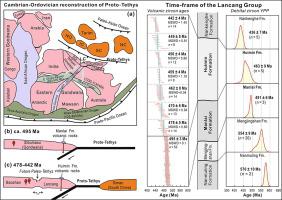Gondwana Research ( IF 6.1 ) Pub Date : 2021-08-30 , DOI: 10.1016/j.gr.2021.08.009 Yuehua Wei 1 , Jian-Wei Zi 1, 2 , Guichun Liu 3, 4 , Zaibo Sun 4 , Guangyan Chen 3, 4 , Tianyu Zhao 5 , Xiaomei Nie 1, 6 , Zhao Yang 1

|
The Lancang Group in SW Yunnan constitutes a pivotal component of the continental margin bounding the Proto- and Paleo-Tethys oceans, yet its formation timing, composition and tectonic affinity remain ill-defined. In this contribution, we present new zircon U-Pb age and whole-rock geochemistry data from volcanic and sedimentary rock units, which are compiled with published data, to refine the depositional age, provenance and nature of the group and its host terrane. The Lancang Group consists of five formations, two of which (Manlai and Huimin) contain abundant metavolcanic rocks. The metavolcanic rocks show a secular change in geochemistry, from EMORB-like calc-alkaline series of the ca. 495 Ma Manlai Formation, to arc-like high-K series of the Huimin Formation. Five metavolcanic samples from the Huimin Formation yielded zircon U-Pb ages between 478 ± 5 Ma and 442 ± 5 Ma. The late Cambrian-Ordovician arc magmatism is related to an active continental margin setting associated with subduction of the Proto-Tethys Ocean. The time-integrated geochemical variation shown by the volcanic rocks likely reflects evolving maturity of the arc system. The youngest detrital zircon ages of the five formations, in conjunction with age constraints from the interbedded volcanic rocks, suggest that the Lancang Group was largely accumulated during the early Paleozoic. The Lancang Terrane is reconstructed as a continental block, which formed part of the magmatically-active margin of the Proto-Tethys during the early Paleozoic. Provenance analysis based on detrital zircon age spectra and Hf isotope data indicates Gondwana affinities of the terrane. Furthermore, xenocrystic zircon ages and zircon Hf and whole-rock Nd model ages from igneous rocks support presence of Neoarchean-Mesoproterozoic basement underlying the terrane. The reconstructed Lancang Terrane bears important implications for understanding the configuration of the northern margin of Eastern Gondwana and the relationship between the Proto- and Paleo-Tethys oceans.
中文翻译:

重建澜沧地体(云南西南)及其对冈瓦纳北缘早古生代原特提斯演化的意义
滇西南澜沧江群是连接原特提斯洋和古特提斯洋的大陆边缘的重要组成部分,但其形成时间、组成和构造亲和力尚不明确。在这篇文章中,我们提供了来自火山和沉积岩单元的新锆石 U-Pb 年龄和全岩地球化学数据,这些数据是根据已发表的数据编制的,以完善该组及其寄主地体的沉积年龄、物源和性质。澜沧群由五个地层组成,其中两个(曼莱和回民)含有丰富的变质火山岩。变质火山岩显示出地球化学的长期变化,来自约 495马曼来组,回民组弧形高K系列。惠民组五个变质火山样品的锆石 U-Pb 年龄介于 478 ± 5 Ma 和 442 ± 5 Ma 之间。晚寒武纪-奥陶纪弧岩浆活动与原始特提斯洋俯冲活动相关的大陆边缘环境有关。火山岩显示的时间综合地球化学变化可能反映了弧系统的成熟度。五个地层中最年轻的碎屑锆石年龄,结合火山岩互层的年龄限制,表明澜沧群在早古生代大量堆积。澜沧地块被重建为一个大陆块,它是早古生代原始特提斯岩浆活动边缘的一部分。基于碎屑锆石年龄谱和 Hf 同位素数据的物源分析表明该地体与冈瓦纳古大陆有亲缘关系。此外,来自火成岩的异晶锆石年龄和锆石 Hf 和全岩 Nd 模型年龄支持地体下存在新太古代-中元古代基底。重建的澜沧地体对于理解冈瓦纳大陆东部北缘的构造以及原始和古特提斯洋之间的关系具有重要意义。


























 京公网安备 11010802027423号
京公网安备 11010802027423号